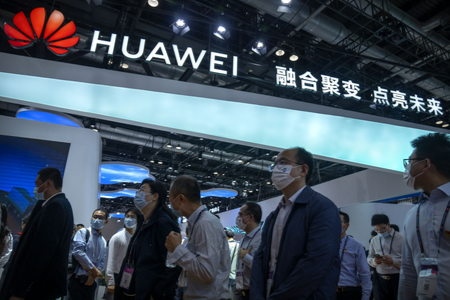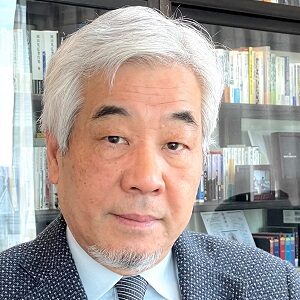Geoeconomic Briefing is a series featuring researchers at the IOG focused on Japan’s challenges in that field. It will also provide analyses of the state of the world and trade risks as well as technological and industrial structures. (Editor-in-chief: Dr. SUZUKI Kazuto, Director, Institute of Geoeconomics (IOG); Professor, The University of Tokyo)
This article was posted to the Japan Times on March 23, 2023:
https://www.japantimes.co.jp/opinion/2023/03/23/commentary/world-commentary/china-chip-industry/
API Geoeconomic Briefing

Photo:AP/アフロ
March 23, 2023
China determined not to be slowed by U.S. chip controls
TOKUCHI Tatsuhito
Consulting Senior Fellow, the Institute of Geoeconomics

In October, U.S. President Joe Biden announced two rules aimed at restricting China’s tech abilities.
The first aims to prevent China from obtaining advanced computing chips, including logic and memory semiconductors with a technology node of 16/14 nanometers or less, and their manufacturing facilities.
The second is an embargo on products and technologies necessary for the development and manufacture of supercomputers.
The sanctions also cover products that go through third countries and U.S. engineers, making it virtually impossible to transfer advanced chip and supercomputer technology to China.
Edward Luce of The Financial Times warned in an opinion piece on Oct. 19 that U.S. efforts to isolate Beijing’s high-tech sector may accelerate Chinese leader Xi Jinping’s bid to take control of Taiwan, saying history is likely to record Biden’s move as the moment when U.S.-China rivalry “came out of the closet.”
China’s fostering of chip industry
Beijing had been focused on nurturing its integrated circuit (IC) industry for some time, but in around 2014, the Chinese government made clear its intention to become self-sufficient in manufacturing technology from the viewpoint of economic security, soon after Xi became the leader of the country, when it issued its National Guideline for the Development and Promotion of the IC Industry.
The guideline was aimed at China promoting the domestic production and industrialization of semiconductors amid the massive surge in demand for chips in the country — constituting around 29% of total global demand.
While hundreds of millions of people owned cell phones, and internet companies and the information technology industry boomed, the share of domestically-made chips was as low as 4%. There were concerns that if Western countries such as the United States implemented export regulations and China’s chip imports were suspended, it would seriously affect not only the country’s electronics industry but other industries, too.
In 2015, when the value of China’s chip imports largely exceeded that of crude oil imports, Beijing launched the “Made in China 2025” initiative. The initiative focused particularly on semiconductors, setting high goals such as mass production of logic chips using 16/14 nm technology by 2020, raising the self-sufficiency rate to 49% and the global market share to 43%. It also aimed to upgrade the entire industry to leading global standards by 2030 and increase the self-sufficiency rate and the global market share to 75% and 46% respectively.
To meet the goals, the Chinese government established in 2014 the National Integrated Circuit Industry Investment Fund, known as the Big Fund, which raised 138.7 billion yuan in its first phase. State-owned financial institutions and local governments actively supported the industry through financial assistance and preferential tax policies. Even unprofitable semiconductor-related companies were allowed to raise capital in the stock market.
A large amount of resources was invested in chip-related industries nationwide, with funds used mainly to procure materials from abroad and acquire human resources from the U.S. and Taiwan. Chinese demand boosted semiconductor-related companies across the world.
However, China failed to meet its goals for 2020. The country has not realized mass production of 16/14 nm chips, and its self-sufficiency rate was around 20% as of the end of 2022.
This was due to sloppy investments, corruption and difficulty in obtaining technologies.
Sloppy investments and corruption issues were rampant under the Big Fund. For example, around 20% of the fund was found to be invested in real estate under the pretext of building a competitive chip ecosystem, and Tsinghua Unigroup, one of China’s major semiconductor players that expanded its business by relying heavily on government support including investments from the fund, declared itself bankrupt due to an inability to repay debts.
Corruption and breach of trust are believed to have underpinned the fund, and in July last year, Chinese authorities detained several executives linked to the fund, including Zhao Weiguo, former chairman of Tsinghua Unigroup, Xiao Yaquing, head of China’s industry and information technology ministry, and Ding Wenwu, head of the fund.
The corruption scandals appear to have impacted the fund’s investment activities, as details of new investment projects are yet to be released. Certainly some investments had proved successful, but sources close to the matter admit that there were indeed dubious and sloppy investments.
Difficulty obtaining technologies
One of the characteristics of the semiconductor industry is that its production process is highly complex, requiring a supply chain stretched across various different stages.
Because the degree of technological integration in each process is high, each field is dominated by a few companies, despite the large size of the market. For instance, South Korea’s Samsung Electronics and SK Hynix together occupy 44% share of the advanced memory chip market, while Taiwan Semiconductor Manufacturing Co. (TSMC) produces 92% of cutting-edge processors.
The semiconductor manufacturing equipment market is dominated by five companies, including ASML of the Netherlands, Applied Materials of the U.S. and Japan’s Tokyo Electron. On the other hand, the market for high-end semiconductor designing software is mostly dominated by the U.S.
Even such companies own core technologies only in their core areas and depend on other firms for many of the other technologies. This makes it difficult for Chinese firms to make significant gains in market share simply by making investments, let alone in a short period of time.
Another key factor that hampered China’s vision was U.S. regulations on Chinese chipmakers and high-tech firms. Amid China’s rapid rise as a military power, consensus grew in Washington on how to suppress the rise.
In 2018, then-U.S. President Donald Trump implemented strict sanctions that restricted some Chinese companies’ ability to sell telecommunications equipment in the U.S. over possible violations of American sanctions on Iran and North Korea and allegations that the companies were included in Beijing’s civil-military fusion plan. The action was aimed at telecommunications equipment manufacturers ZTE and Huawei Technologies.
Such moves derailed China’s plans.
Ban on GPU exports
In implementing the latest chip export controls, the U.S. focused on China’s fast-growing artificial-intelligence market. If Beijing beats the Washington in this field, it is highly likely that China will dramatically boost efficiency in every sector and outstrip the U.S.
Washington’s National Defense Strategy released in October states that the Chinese Liberation Army is rapidly advancing and integrating its space, counterspace, cyber, electronic and information warfare capabilities, while the National Security Strategy says that the U.S. military is investing in a range of advanced technologies, including those in the cyber and space domains, missile defeat capabilities, trusted artificial intelligence and quantum systems.
The growth of China’s AI industry was indeed tremendous. Kai-Fu Lee, a leading expert on AI in China, wrote in his 2018 book “AI Superpowers: China, Silicon Valley, and the New World Order” that while China is currently far behind the U.S. in the field of autonomous AI, if state-of-the-art technologies such as graphics processing unit (GPU)-accelerated image recognition spread quickly, there will be no differences between the U.S. and China in the field of autonomous vehicles, and China will achieve dominance over the U.S. in hardware such as autonomous drones five years from now.
Considering China’s superiority in big data and talented AI engineers, China would be the one to benefit the most from AI in the future, he said.
Although Lee predicted the rapid spread of GPUs, it was beyond his expectations that it would become impossible for China to obtain them. The market for GPUs, high-end chips used as core technology in everything from image recognition to autonomous driving, is currently dominated by products from Nvidia — a U.S. firm that first developed the product for video games — that are manufactured by TSMC.
On Jan. 31, Xi noted that it is imperative to move faster toward self-reliance in science and technology so as to relieve the stranglehold some countries have tightened on China’s development of core technologies.
GPUs are definitely affected by that stranglehold, and by banning exports of technology to produce them, the U.S. is aiming to prevent China from becoming an AI advanced military power.
Economic historian Chris Miller, in his recently-released book “Chip War,” predicts that, due to U.S. export controls, it has become difficult for China to catch up in five years or even 10. The U.S. action is causing great damage to Beijing’s dream of becoming a superpower.
Future of China’s chip industry
It is premature, however, to think that would lead to the deterioration of China’s entire semiconductor industry.
The latest U.S. export controls target advanced chips using the 16/14 nm technology nodes which are used in supercomputers and high-level AI, but don’t include general-purpose chips using mature technologies. While the unit price for advanced chips is high, they are said to occupy only a small proportion of the market, and general-purpose chips are definitely in high demand. This means there is little possibility for major sanctions to be imposed on general-purpose chips and related products, since such sanctions would lead to a loss of massive Chinese demand, resulting in a severe blow to Western countries.
China is currently making a shift to mass production of general-purpose chips with an aim to adjust and restart its plan to develop advanced chips. Semiconductor Manufacturing International, China’s top chipmaker, which has been initiating mass production of 14 nm chips, is boosting its mass production of 28 nm chips. The firm has now risen to fifth among the world’s top foundries by revenue, holding a market share of 5.3%.
Hua Hong Semiconductor, the country’s No. 2 chipmaker, is also quickly moving to have mass production capacity of a similar level. Huawei Technologies, with its strong research and development capabilities, is accelerating investment in building its own semiconductor ecosystem, drawing the industry’s attention to its possible achievements in the years to come.
AI entrepreneurs rich in creativity keep on making a big change to Chinese society, making full use of general-purpose chips and the power of big data. China will continue to be a formidable player.
Time for perseverance
It is possible that Luce went a little too far in saying Washington’s strengthened controls over semiconductor exports to China will lead to greater possibilities for a Taiwan contingency. It is unlikely that Beijing will invade Taiwan in a bid to change the current situation. Even if an invasion proved successful, it wouldn’t allow China to obtain advanced chips whose supply chains spread worldwide.
The question still remains as to whether China could carry out an invasion to prevent its enemies from acquiring advanced chips. But that option would not be reasonable either, considering the high costs. Strict economic sanctions would cause a collapse of China’s dual-circulation economy — the strategy of emphasizing both expanded domestic demand and growing exports, with the two reinforcing each other.
In response to the latest export controls, Beijing only went as far as initiating a dispute at the World Trade Organization. This is possibly because China fully understands the seriousness of sanctions, recognizes that the situation will not change soon no matter how hard it struggles and thinks now is the time for perseverance.
Disclaimer: The views expressed in this API Geoeconomic Briefing do not necessarily reflect those of the API, the Institute of Geoeconomics (IOG) or any other organizations to which the author belongs.
 APIニュースレター 登録
APIニュースレター 登録